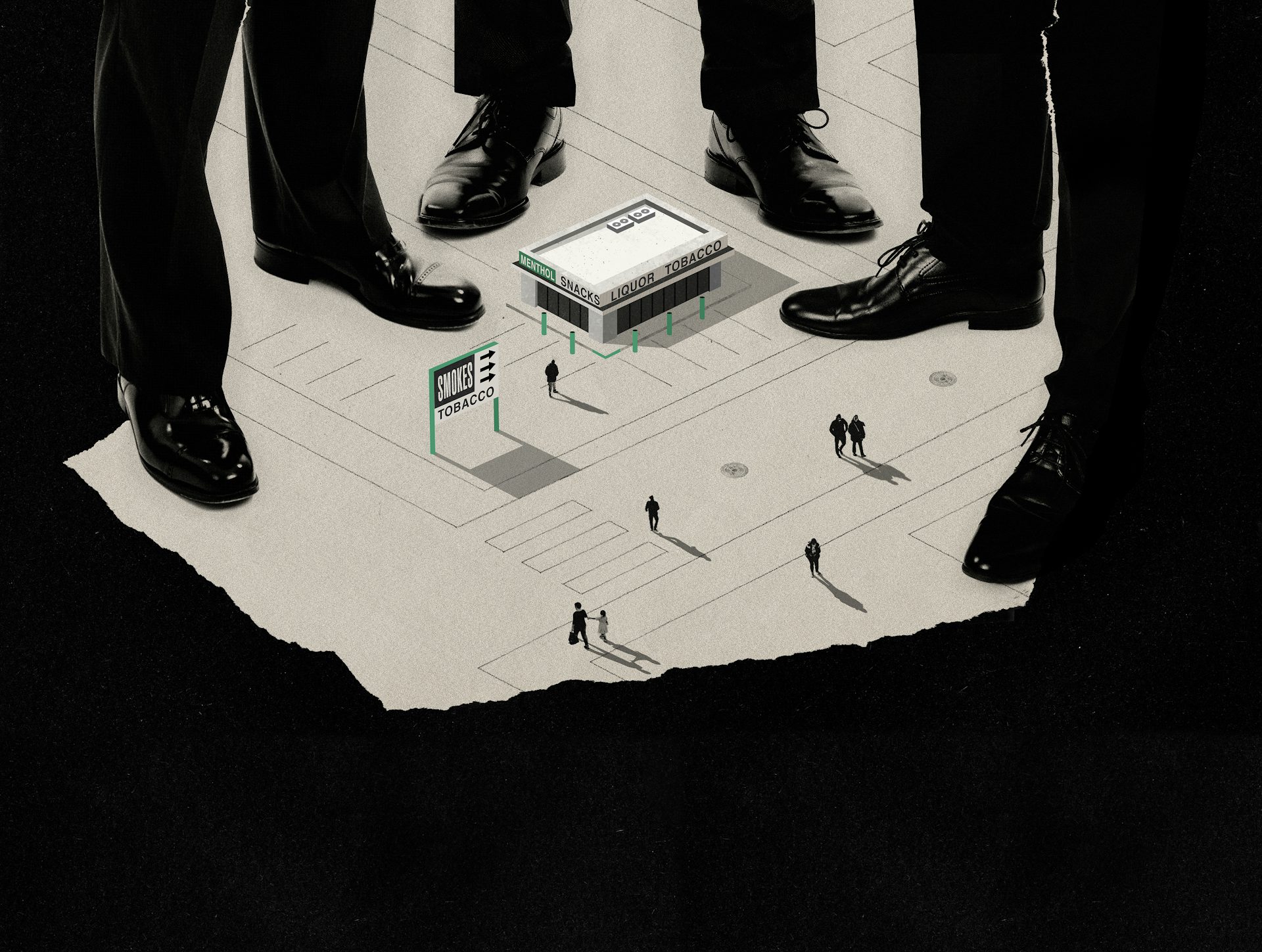- U.S. Department of Health and Human Services. Tobacco Use Among U.S. Racial/Ethnic Minority Groups—African Americans, American Indians and Alaska Natives, Asian Americans and Pacific Islanders, and Hispanics: A Report of the Surgeon General. Atlanta, Georgia: U.S. Department of Health and Human Services, Centers for Disease Control and Prevention, National Center for Chronic Disease Prevention and Health Promotion, Office on Smoking and Health, 1998.
- Lee JG, Sun DL, Schleicher NM, Ribisl KM, Luke DA, Henriksen L. Inequalities in tobacco outlet density by race, ethnicity and socioeconomic status, 2012, USA: results from the ASPiRE Study. J Epidemiol Community Health. 2017;71(5):487-492. doi:10.1136/jech-2016-208475.
- Lee JG, Henriksen L, Rose SW, Moreland-Russell S, Ribisl KM. A Systematic Review of Neighborhood Disparities in Point-of-Sale Tobacco Marketing. Am J Public Health. 2015;105(9):e8-18.
- Tobacco Control Legal Consortium. Evans v. Lorillard: A Bittersweet Victory Against the Tobacco Industry. https://publichealthlawcenter.org/sites/default/files/resources/tclc-Evans-v-Lorillard-case-study-2016.pdf. Accessed April 14, 2022.
- California Department of Public Health, California Tobacco Control Program. California Tobacco Facts and Figures 2021. Sacramento, CA: California Department of Public Health; November 2021.
- Centers for Disease Control and Prevention. Smoking and Tobacco Use: Trends and disparities in secondhand smoke. Updated May 15, 2024. Accessed July 3, 20024. https://www.cdc.gov/tobacco/secondhand-smoke/disparities.html
- Henriksen L, Schleicher NC, Dauphinee AL, Fortmann SP. Targeted advertising, promotion, and price for menthol cigarettes in California high school neighborhoods. Nicotine Tob Res. 2012;14(1):116-121. doi:10.1093/ntr/ntr122.
- Truth Initiative. Why are 72% of smokers from lower-income communities? Truthinitiative.org. https://truthinitiative.org/research-resources/targeted-communities/why-are-72-smokers-lower-income-communities. Published January 24, 2018. Accessed April 14, 2022.
- McCarthy WJ, Mistry R, Lu Y, Patel M, Zheng H, Dietsch B. Density of tobacco retailers near schools: effects on tobacco use among students. Am J Public Health. 2009;99(11):2006-2013. doi:10.2105/AJPH.2008.145128.
- Truth Initiative. How tobacco companies linked cigarettes and mental health.truthinitiative.org. https://truthinitiative.org/research-resources/targeted-communities/how-tobacco-companies-linked-cigarettes-an. Published August 23, 2017. Accessed February 16, 2022.
- Truth Initiative. Achieving Health Equity in Tobacco Control. trutinitiative.org. https://truthinitiative.org/research-resources/targeted-communities/achieving-health-equity-tobacco-control. Published December 15, 2015. Accessed April 14, 2022.
- Minosa MK. Tobacco Use and Hispanics. Campaign for Tobacco-Free Kids. https://www.tobaccofreekids.org/assets/factsheets/0134.pdf. Published March 18, 2022. Accessed April 14, 2022.
- American Cancer Society. Big Tobacco Targets the LGBTQ+ Community. Updated December 15, 2022. Accessed July 8, 2024. https://www.fightcancer.org/sites/default/files/tobacco_industry_targeting_of_lgbtq_community_12.2022_final.pdf
- Truth Initiative. Tobacco is a social justice issue: Racial and ethnic minorities. Truthinitiative.org. https://truthinitiative.org/news/tobacco-social-justice-issue-racial-and-ethnic-minorities. Published February 3, 2017. Accessed April 14, 2022.
- D'Silva J, O'Gara E, Villaluz NT. Tobacco industry misappropriation of American Indian culture and traditional tobacco. Tob Control. 2018;27(e1):e57-e64. doi:10.1136/tobaccocontrol-2017-053950.
- Muggli ME, Pollay RW, Lew R, Joseph AM. Targeting of Asian Americans and Pacific Islanders by the tobacco industry: results from the Minnesota Tobacco Document Depository. Tob Control. 2002;11(3):201-209. doi:10.1136/tc.11.3.201.
- California Department of Public Health, California Tobacco Control Program, California Facts and Figures 2021, Sacramento, CA: California Department of Public Health; November 2021.
- American Lung Association. Cutting tobacco’s rural roots: Tobacco use in rural communities. Chicago, IL: American Lung Association;2012.
- Robinson RG, Sutton CD, James DA, Orleans CT. Pathways to Freedom: Winning the Fight against Tobacco. Department of Health and Human Services, Centers for Disease Control and Prevention: Atlanta, GA; 2003.
- Primack BA, Bost JE, Land SR, Fine MJ. Volume of tobacco advertising in African American markets: systematic review and meta-analysis. Public Health Rep. 2007;122(5):607-15.
- Resnick EA, Jackson KL, Barker DC, Chaloupka FJ. Cigarette Pricing Differs by U.S. Neighborhoods—A BTG Research Brief. Chicago, IL: Bridging the Gap Program, Health Policy Center, Institute for Health Research and Policy, University of Illinois at Chicago, 2012.
- Federal Trade Commission. Federal Trade Commission Cigarette Report for 2020. Washington, D.C.: Federal Trade Commission. 2021.
- OpenSecrets. Industry Profile: Tobacco. Opensecrets.org. https://www.opensecrets.org/federal-lobbying/industries/summary?cycle=2021&id=A02. Accessed March 16, 2022.
- Office on Smoking and Health (US). The Health Consequences of Involuntary Exposure to Tobacco Smoke: A Report of the Surgeon General. Atlanta (GA): Centers for Disease Control and Prevention (US); 2006.
- R.J. Reynolds. Younger Adult Smokers: Strategies and Opportunities. https://www.industrydocuments.ucsf.edu/docs/rkvk0045. 1984 February 29.
- Anderson SJ. Marketing of menthol cigarettes and consumer perceptions: a review of tobacco industry documents. Tob Control. 2011;20 Suppl 2(Suppl_2):ii20-ii28. doi:10.1136/tc.2010.041939.
- Break Free From Plastic. Branded Vol. III: Demanding corporate accountability for plastic pollution. 2020.
- Poma A, Vecchiotti G, Colafarina S, et al. In Vitro Genotoxicity of Polystyrene Nanoparticles on the Human Fibroblast Hs27 Cell Line. Nanomaterials (Basel). 2019;9(9):1299. Published 2019 Sep 11. doi:10.3390/nano9091299.
- Zarus GM, Muianga C, Hunter CM, Pappas RS. A review of data for quantifying human exposures to micro and nanoplastics and potential health risks. Sci Total Environ. 2021;756:144010. doi:10.1016/j.scitotenv.2020.144010.
- Jacob H, Besson M, Swarzenski PW, Lecchini D, Metian M. Effects of Virgin Micro- and Nanoplastics on Fish: Trends, Meta-Analysis, and Perspectives. Environ Sci Technol. 2020;54(8):4733-4745. doi:10.1021/acs.est.9b05995.
- Ziv-Gal A, Flaws JA. Evidence for bisphenol A-induced female infertility: a review (2007-2016). Fertil Steril. 2016;106(4):827-856. doi:10.1016/j.fertnstert.2016.06.027.
- Campanale C, Massarelli C, Savino I, Locaputo V, Uricchio VF. A Detailed Review Study on Potential Effects of Microplastics and Additives of Concern on Human Health. Int J Environ Res Public Health. 2020;17(4):1212. Published 2020 Feb 13. doi:10.3390/ijerph17041212.
- Belzagui F, Buscio V, Gutiérrez-Bouzán C, Vilaseca M. Cigarette butts as a microfiber source with a microplastic level of concern. Science of The Total Environment. 2021;762:144165. doi:10.1016/j.scitotenv.2020.144165.
- Governor Newsom Signs Legislation Making California First in the Nation to Ban Toxic Chemicals in Cosmetics [press release]. gov.ca.gov. https://www.gov.ca.gov/2020/09/30/governor-newsom-signs-legislation-making-california-first-in-the-nation-to-ban-toxic-chemicals-in-cosmetics/. Published September 30, 2020. Accessed March 23, 2022.
- Landmark California law bans 'forever chemicals' in products for infants, children [press release]. ewg.org. https://www.ewg.org/news-insights/news-release/2021/10/landmark-california-law-bans-forever-chemicals-products-infants. Published October 5, 2021. Accessed March 23, 2022.

